Fisheries and Ecotoxicology Research Laboratory, Department of Zoology, University of Burdwan, West Bengal, India.
Corresponding author email: ncsaha@zoo.buruniv.ac.in
Article Publishing History
Received: 13/03/2021
Accepted After Revision: 15/06/2021
The present study was made to find out the health status of a wetland Muragacha Beel, District North 24 Parganas, West Bengal, India. The study focused on the seasonal fluctuation of physicochemical parameters of water and diversity of fish fauna during pre-monsoon, monsoon, and post-monsoon from March 2019 to February 2020. Water samples and fish specimens were collected from three different sites of the beel every month to evaluate the correlation between physicochemical properties of water and the indices of fish diversity. A significant seasonal fluctuation in fish diversity (2.762-2.796) in relation to physicochemical parameters (temperature 20.2-32.8ºC, turbidity 23.1-30.1 cm, pH 7-8.5, carbon dioxide0-15.6 mg/l, dissolved oxygen 4.5-5.9 mg/l, biochemical oxygen demand 2.6–7 mg/l, alkalinity 148-194 mg/l, hardness 106-168 mg/l, phosphate 0.43-1.25 mg/l and nitrate 0.17-0.45 mg/l of water) was recorded during the study period. In respect of fish faunal diversity, a total of 25 species belonging to 6 orders and 16 families were identified.
Maximum representatives belong to the order Cypriniformes having 6 species with 44.6% Relative Abundance, followed by Clupeiformes with 2 species with 18.6% Relative Abundance. The beel was heavily infested with aquatic vegetation creating complex environments for the growth of different fauna. The present study indicates that the beel is moderately productive and suitable for commercial aquaculture. The effect of seasonal variations on the assemblage of fish composition is found to be important and it should be considered into account when developing initiatives that will be taken in the future to support the productivity and biodiversity of the wetland.
PCA, Pearson Correlation, Physicochemical Properties, Seasonal Fluctuation, Shannon-Weiner Index.
Triparna C, Arnab C, Chandra S. N. Seasonal Fluctuations in Physicochemical Parameters of Water in Relation to Fish Diversity: In Muragacha Beel, West Bengal India. Biosc.Biotech.Res.Comm. 2021;14(2).
Triparna C, Arnab C, Chandra S. N. Seasonal Fluctuations in Physicochemical Parameters of Water in Relation to Fish Diversity: In Muragacha Beel, West Bengal India. Biosc.Biotech.Res.Comm. 2021;14(2). Available from: <a href=”https://bit.ly/3e88L8m“>https://bit.ly/3e88L8m</a>
Copyright © This is an Open Access Article distributed under the Terms of the Creative Commons Attribution License (CC-BY). https://creativecommons.org/licenses/by/4.0/, which permits unrestricted use distribution and reproduction in any medium, provided the original author and sources are credited.
INTRODUCTION
Wetlands are highly diversified and productive ecosystems. Huge numbers of biodiversity are found within the lap of the wetland (Groombridge and Jenkins 1998; Ramachandra et al. 2006). The existence of aquatic life is completely dependant on the health status of wetlands. Constant surveillance is needed to conserve and protect this treasure of nature (Ramachandra et al. 2006; Ramesh et al. 2007). Freshwater wetlands in India are not only rich in fish biodiversity but also support a fashionable source of zooplankton, phytoplankton and macroinvertebrate species. The primary aim to maintain the health status of any wetland is to keep its physicochemical parameters within desirable limits (Khan 2002; Garg et al. 2010).
The diversity of the aquatic community varies greatly with seasonal fluctuation. The fluctuation of water quality parameters is considered a vital factor to analyze the species’ biodiversity (Mondal et al. 2010; Jagadeeshappa and Kumara 2014). The physicochemical parameters play an important role to study any aquatic environment (Jagadeeshappa and Kumara 2014). The alteration in the physicochemical status of water directly influences the composition of aquatic flora and fauna. There are more than 150 floodplain lakes in West Bengal, covering a 42,000-ha area, contributing to about 22 percent of the freshwater habitat of the entire state (Bhaumik et al. 2003; Singh et al. 2017).
Among them, the North 24 Parganas district possesses a huge amount (8861ha) of water resources. Subsequent deterioration of water quality could be a serious threat to the fish biodiversity and productivity of floodplain lakes in the state. The present study was administrated to measure the magnitude of the physicochemical parameters of water and its relation with the fish biodiversity indices of Muragacha Beel. The area is mainly rain-fed. The fisherman utilizes this wetland for fish capture. Sewage from the municipality, domestic disposal directly mixes up in this wetland. The reason behind the selection of this particular beel is to assess its health status and its suitability for fish culture (Mondal and Kaviraj, 2008; Mondal et al. 2010).
In India, multiple studies have been carried out to analyze the physicochemical parameters of aquatic bodies (Azmi et al. 2015). Ansari (2017) carried out the water quality analysis of Surajpur wetland, UP to check the relationship among various physicochemical parameters in both temporal and spatial scales. Multiple pieces of research are done to analyze the water samples on several wetlands in the state. But inadequate information is found regarding the physicochemical properties and fish assemblage of this particular wetland (Azmi et al. 2015; Ansari 2017). So, an investigation has been done to research the physicochemical status of water and diversity of fish fauna during pre-monsoon, monsoon and post-monsoon from March 2019 to February 2020.
MATERIAL AND METHODS
Muragacha beel (Latitude 22°41’58.7″N; Longitude 88°25’3.8″E) (Figure 1) falls under the North 24 Parganas districts of West Bengal, India, at an altitude of 6 meters above sea level. Muragacha Beel spreads over an area of 10.3 hectares.
Figure 1: Map (source: Wikipedia and Google Satellite Map) of the study area with three sites pointed as Site1, Site2 and Site3.
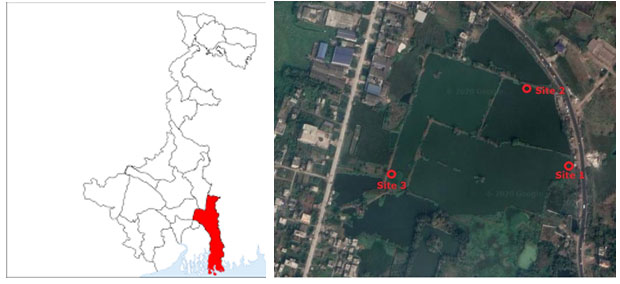
The study was conducted on monthly basis from March 2019 to February 2020 for the analysis of physicochemical parameters and the relationship of those parameters with fish diversity. A total of three representative sampling sites (Site1, Site2 and Site3) were selected. The most changeable and sensitive water quality parameters such as Water Temperature, pH, Transparency (Turbidity), Dissolved Oxygen (DO) and Free CO2 were measured in-situ, while rest parameters (BOD, Total Hardness as CaCO3, Total Alkalinity as CaCO3, Nitrate, and Phosphate) were analyzed in the laboratory. The collection of water samples was done between 5 am to 8 am. Sample preservation and evaluation of different water quality index were performed according to standard procedures (APHA, 2005; APHA, 2012; Chattopadhyay, 1998). The outcomes of the physicochemical study of the water sample were matched with the World Health Organisation (2011) standard (Panigrahi and Subhasini, 2020).
Table 1. Water quality parameters as per World Health Organization (2011)
| Sl No | Physicochemical Parameters | Permissible Limits* |
| 1 | Water Temperature (0C) | <40 |
| 2 | pH | 6.5 – 8.5 |
| 3 | Turbidity (Transparency) (cm) | <100 |
| 4 | Dissolved oxygen (DO) (mg/l) | 3.0 – 6.0 |
| 5 | Free CO2(mg/l) | <12 |
| 6 | Biochemical oxygen demand (BOD) (mg/l) | 2.0 – 8.0 |
| 7 | Total hardness as CaCO3 (TH)(mg/l) | 200 |
| 8 | Total alkalinity as CaCo3 (TA) (mg/l) | 200 |
| 9 | Phosphate (PO43-)(mg/l) | 5 |
| 10 | Nitrate (NO3–)(mg/l) | <45.0 |
The fishes were captured at three stations with local nets and their identification was confirmed by the method used by Armantrout et al. (1994). The diversity and evenness indices were calculated by the references of Shannon et al. (1950). Pearson linear correlation was carried out to see the connection between various physicochemical parameters. To evaluate the diversity indices, random fish samples were extracted from five nettings across each site were collected to produce a 1kg sample of small wild fish for every site per month. From these data Shannon-Weiner species diversity index , Evenness index(J), Index of Dominance (ID) and Relative Abundance (RA) were determined using the following equations (Shannon et al. 1950; Armantrout et al. 1994):

The limnological data of the study period was assembled for three seasons and assessment was done for seasonal variations, viz., Pre-monsoon (from March to June), Monsoon (from July to October), and Post-monsoon (from November to February). Mean, Standard Error of Mean and One-way analysis of variance (ANOVA) for various parameters for three seasons and multivariate statistical analysis PCA (Principal Component Analysis) were performed using XLSTAT 2020 and GraphPad Prism9. Tukey HSD tests were carried out to measure the significant difference at the 5% probability (α) level (Shannon et al. 1950; Armantrout et al. 1994).
RESULTS AND DISCUSSION
Seasonal variation of the physicochemical parameters of water (water temperature, pH, turbidity, dissolved oxygen, free carbon dioxide, biochemical oxygen demand, total alkalinity, total hardness, nitrate, and phosphate) of Muragacha beel in pre-monsoon, monsoon, and post-monsoon season are showed in table 2.
In this study the range of the physicochemical parameters viz., water temperature 20.2-32.8ºC, turbidity 23.1-30.1 cm, pH 7-8.5, carbon dioxide0-15.6 mg/l, dissolved oxygen 4.5-5.9 mg/l, biochemical oxygen demand 2.6–7 mg/l, alkalinity 148-194 mg/l, hardness 106-168 mg/l, phosphate 0.43-1.25 mg/l and nitrate 0.17-0.45 mg/l was found. The results of the Pearson correlation test were further verified through Principal Component Analysis (PCA). In Muragacha beel water temperature showed a positive correlation with turbidity and CO2 whereas a negative correlation with pH, dissolved oxygen, BOD, total alkalinity, nitrate, and phosphate (Table 3). Ziauddin et.al., (2013) reported that minimum and maximum temperature in beels of West Bengal varied from 17.5 to 35.0 °C, which conforms with the present study.
The higher pH was recorded in post-monsoon due to the low level of water, higher nutrient content. The range of pH showed sub-alkaline in nature (7.0 to 8.5) that was within the permissible limit as prescribed by WHO (2011). In Muragacha beel, pH showed a positive correlation with DO, BOD, total hardness and total alkalinity while showed a negative correlation (Table–3, Fig. 2) with nitrate, water temperature and CO2. The results of the present investigation are comparable with Panigrahi and Debnath (2013).
A water body’s transparency usually suggests its effectiveness. Throughout the monsoon month, it was found to be a maximum that may be attributed to the entry of rainwater from the surrounding area. Throughout pre-monsoon and post-monsoon it was generally low which shows similarities to the earlier work of Kumar et al. (2019). In Muragacha beel, turbidity showed a positive correlation (Table–3, Fig. 2) with dissolved oxygen, nitrate and phosphate whereas it showed a negative correlation with CO2, BOD and total hardness (Panigrahi and Debnath 2013).
Table 2. Different letters (a-b) indicates a significant difference (p<0.05) within the same row (One way ANOVA followed by Tukey test)
| Pre-Monsoon | Monsoon | Post-Monsoon | |
| W T (0C) | 28.63 ± 2.76a | 30.08 ± 1.8a | 22.28 ± 2.35b |
| pH | 7.16 ± 0.12a | 7.43 ± 0.21a | 8.18 ± 0.23b |
| TUR (cm) | 25.98 ± 2.02a | 29.54 ± 0.46a | 26.98 ± 2.35a |
| DO (mg/l) | 5.32 ± 0.78a | 6.67 ± 1.02b | 8.29 ± 0.58b |
| CO2 (mg/l) | 8.46 ± 3.01a | 6.09 ± 2.42a | 2.6 ± 1.39b |
| BOD (mg/l) | 4 ± 0.99a | 5 ± 0.77a | 6 ± 0.63a |
| TH (mg/l) | 133 ± 7.22a | 125 ± 6.64a | 144 ± 24.5a |
| TA(mg/l) | 159 ± 7.6a | 176 ± 10.97a | 178 ± 17.18a |
| NO3 (mg/l) | 0.21 ± 0.02a | 0.3 ± 0.09a | 0.22 ± 0.03a |
| PO4– (mg/l) | 0.59 ± 0.06a | 0.71 ± 0.2a | 0.67 ± 0.09a |
Table 3. Correlation matrix among the physicochemical parameters and Shannon-Wiener diversity Index of Muragacha beel wetland from March 2019 to February 2020.
| W T | pH | TUR | DO | CO2 | BOD | TH | TA | NO3 | PO4– | SW I | |
| W T (0C) | 1.00 | ||||||||||
| pH | -0.91 | 1.00 | |||||||||
| TUR (cm) | 0.41 | 0.00 | 1.00 | ||||||||
| DO (mg/l) | -0.58 | 0.87 | 0.50 | 1.000 | |||||||
| CO2 (mg/l) | 0.83 | -0.99 | -0.16 | -0.94 | 1.00 | ||||||
| BOD(mg/l) | -0.99 | 0.85 | -0.53 | 0.47 | -0.75 | 1.00 | |||||
| TH (mg/l) | -0.97 | 0.77 | -0.64 | 0.35 | -0.66 | 0.99 | 1.00 | ||||
| TA(mg/l) | -0.40 | 0.75 | 0.66 | 0.98 | -0.85 | 0.28 | 0.16 | 1.00 | |||
| NO3 (mg/l) | 0.62 | -0.24 | 0.97 | 0.28 | 0.08 | -0.72 | -0.80 | 0.46 | 1.00 | ||
| PO4– (mg/l) | 0.00 | 0.41 | 0.91 | 0.81 | -0.56 | -0.13 | -0.26 | 0.91 | 0.78 | 1.00 | |
| SW I | -0.52 | 0.82 | 0.57 | 1.00 | -0.91 | 0.40 | 0.28 | 0.99 | 0.35 | 0.86 | 1.00 |
** WT=Water Temperature, TUR=turbidity, DO=Dissolve Oxygen, CO2=Carbon Di Oxide, BOD= Biochemical Oxygen Demand, TH=Total Hardness, TA=Total Alkalinity, PO4– =Phosphate, NO3= Nitrate, SWI = Shannon Wiener Index.
Figure 2: Heatmap of Pearson correlation matrix between different physicochemical parameters and Shannon-Wiener diversity Index of Muragacha beel from March 2019 to February 2020.
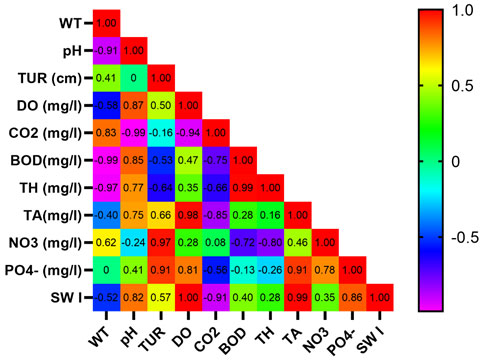
Dissolved oxygen attributes are inversely related to the temperature cycle, differing from post-monsoon upside to pre-monsoon lowest point. Chaurasia and Tiwari (2011), also reported similar observations in a freshwater beel of Bhagalpur in Bihar. In the present investigation, dissolved oxygen of the wetlands shows a negative correlation (Table-3, Fig.2) with temperature, CO2 and nitrate but showed a positive correlation with pH and phosphate (Chaurasia and Tiwari 2011).
Free CO2 was relatively high during the summer months, which can be due to the faster decomposition of organic matter and high temperature. Lacking free carbon dioxide in other seasons could be due to its utilization by phytoplankton and other aquatic plants via photosynthesis. The free carbon dioxide shows a significant positive correlation with temp and nitrate while negative with the rest of the parameters which similar to Hassan et al. (2011) and Shinde et al. (2011).
The maximum total hardness was obtained in post-monsoon due to some construction activity. Ansari (2017), also reported similar observations in the Surajpur wetland. In Muragacha beel, total hardness showed a negative correlation with water temp, turbidity, CO2 and phosphate but showed a positive correlation with pH, BOD and DO. The results of total alkalinity obtained from the present study were in close conformity with the findings of Mishra et al. (2014) and Arya et al. (2011). In Muragacha beel, total alkalinity showed a positive correlation with pH, DO, BOD, nitrate and phosphate but showed a negative correlation with water temperature and CO2 (Jain et al. 1996; Gupta et al. 2016).
The amounts of nitrate in all three sites of this beel were found very low. During the monsoon period, however, the level of nitrate was found a bit high due to the surface runoff and some microbial activity. In monsoon, the activities of these microbes go down resulting in a higher value of nitrate (Kaur et al. 1996). In Muragacha beel, nitrate showed a positive correlation with phosphate, TA and water temp but a negative correlation with pH, DO and BOD. Phosphorus in water commonly exists as phosphate. The phosphate concentration in water above 0.5 mg l-1 indicates pollution (Jain et al. 1996).
Maximum phosphate was observed in Muragacha beel during the monsoon and minimum during the pre-monsoon. In Muragacha beel, phosphate showed a negative correlation (Table-3, Fig.2) with water BOD, Total hardness and CO2 while a positive correlation with pH, DO and nitrate was observed. The concentration of phosphate which was moderate throughout the year indicates that this beel is mesotrophic. A mesotrophic wetland system has intermediate levels of phosphorus and is suitable for the growth of aquatic plants and fishes (Gupta et al. 2016).
Figure 3: Quadrant distribution of different water physicochemical parameters of water of Muragacha beel throughout the year via PCA.
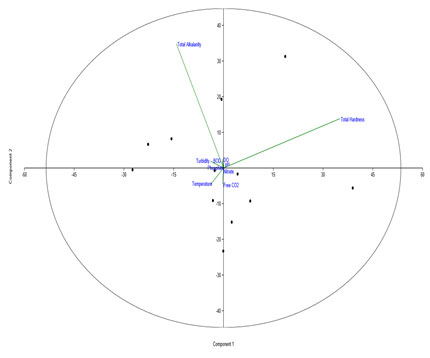
Figure 4: Scree plot showing the eigenvalues, principal components and broken stick derived from PCA regarding the different water physicochemical parameters of water of Muragacha beel.
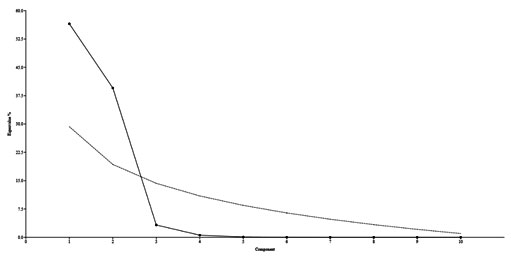
Figure 5: Factor loading plot of principal component 1 showing different water physicochemical parameters of water of Muragacha beel derived from PCA.
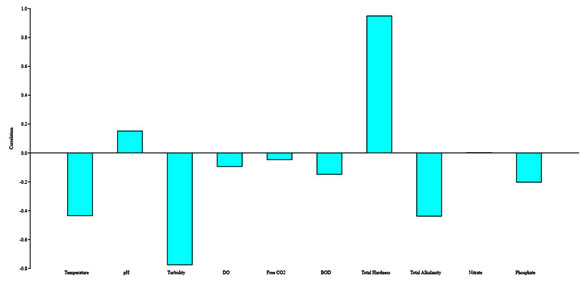
The results described above indicate that the physicochemical parameters studies were within acceptable limits and the water quality of this beel was good enough to support rich high species diversity and suitable for fish culture. This is also relevant to Bhatnagar and Devi (2013), where they found most of the physicochemical parameters were within the target range (Bhatnagar and Devi 2013).
25 species of fishes belonging to 6 orders, 16 families and 22 genera were obtained from the Muragacha beel wetland. Out of those fishes, Cypriniformes was the most dominating order having 6 species with 44.6% Relative Abundance, followed by Clupeiformes with 2 species and 18.6% Relative Abundance, Siluriformes with 5 species and 15.2% Relative Abundance, Perciformeswith 9 species and 14.8% Relative Abundance, Synbranchiformes with 2 species and 5.5% Relative Abundance and Osteoglossiformes with 1 species and 1.3% Relative Abundance (Roy et al. 2013).
Table 4. Species diversity indices in three different seasons
| Shannon-Wiener Index | Evenness Index | Index of Dominance | |
| Pre-Monsoon | 2.762 | 0.858 | 0.080 |
| Monsoon | 2.789 | 0.866 | 0.078 |
| Post-Monsoon | 2.796 | 0.868 | 0.077 |
Shannon-Wiener diversity index (H) was obtained highest (2.796) in Post-Monsoon and lowest (2.762) in pre-monsoon. Similarly, the species evenness was found highest in post-monsoon (0.868) and lowest in pre-monsoon (0.858). Both Shannon-Wiener diversity index (H) and evenness index highest during post-monsoon, while the index of dominance was lowest during post-monsoon (0.077) and similarly it was observed that the index of dominance highest during pre-monsoon (0.080) but the evenness index and Shannon-Wiener diversity index lowest(Table 4).
The Shannon-Wiener diversity index shows a negative correlation with water temperature and CO2 while positive relation with the other parameters like pH, DO, BOD, and phosphate. The dominance index increases with the harshness of the environment (Karr, 1971) while the evenness index decreases with the increase in stress in the environment (Chapin et al. 2000). Natural and anthropogenic activities directly impact the relative abundance of species until it becomes an endangered species (Roy et al. 2013). In this present study, the Shannon-Wiener diversity indices suggest that the water of Muragacha beel is healthy, which was compared with Jewel et al. (2018).
CONCLUSION
This is the first report of Muragacha beel which showed that this beel has immense potential to sustain good biodiversity and ideal for aquaculture. Most of the physicochemical parameters were within the target range of water quality guidelines of the Central Pollution Control Board, India. Results of phosphate and nitrate concentration in the present study and result of fish diversity indicate that the beel is Mesotrophic. However, there is significant seasonal fluctuation in the water quality along with fish diversity. Finally, it is concluded that the beel is productive and suitable for pisciculture.
ACKNOWLEDGEMENTS
Authors acknowledge the facilities of research provided by Prof. Soumendranath Chatterjee, Department of Zoology, University. The authors are thankful to fishermen associated with Muragacha beel wetland for their needful help.
Conflict of Interests: Authors have declared that there is no conflict of interest.
Ethical Clearance Statement: The Current Research Work Was Ethically Approved by the Institutional Review Board (IRB) of University of Burdwan, West Bengal, India.
REFERENCES
APHA (2005) Standard methods for the examination of water and wastewater 21sted Washington DC New York: American Public Health Association
APHA (2012) Standard methods for the examination of water and wastewater 22nded Washington DC New York: American Public Health Association
Ansari N A (2017) Seasonal variations in physicochemical characteristics of water samples of surajpur wetland national capital region India International journal of current microbiology and applied sciences 6(2) pp 971–987
Armantrout N B Talwar P K and Jhingram A G (1994) Inland fishes of India and adjacent countries Copeia 1994(3) p 828
Arya S Kumar V Raikwar M Dhaka A and Minakshi (2011) Physico-chemical Analysis of Selected Surface Water Samples of Laxmi Tal (Pond) in Jhansi City UP Bundelkhand Region Central India Journal of Experimental Sciences 2(8) pp 1–6
Azmi N Anwar M R and Kumari M (2015) Water quality analysis of fish pond of Araria district Bihar Ind J Appl Res 5(1) pp 587–589
Bhatnagar A and Devi P (2013) Water quality guidelines for the management of pond fish culture International Journal of Environmental Sciences 3(6) pp 1980–2009
Bhaumik U Jha B C Mitra K and K G (2003) Vinci Fish yield optimization in beels: Some case studies from West Bengal Bulletin of Central Inland Fisheries Research Institute Barrackpore (125) pp 43–54
Chapin F S Zavaleta E S Eviner V T Naylor R L Vitousek P M Reynolds H L Hooper D U Lavorel S Sala O E Hobbie S E Mack M C and Díaz S (2000) ‘Consequences of changing biodiversity’ Nature 405(6783) pp 234–242
Chattopadhyay N G (1998) Chemical analysis of fish pond soil and water Delhi: Daya Publishing House
Chaurasia N K and Tiwari R K (2011) Effect of industrial effluents and wastes on physicochemical parameters of River Rapti Advance in Applied Science Research 2(5) pp 207–211
Garg R Rao R Uchchariya D Shukla G and Saksena D (2010) Seasonal variations in water quality and major threats to Ramsagar reservoir India African Journal of Environmental Science and Technology 4(2) pp 61–76
Groombridge B and Jenkins M (1998) Freshwater Biodiversity: A Preliminary Global Assessment Cambridge United Nations Environment Programme World Conservation Monitoring Center World Conservation Press
Gupta D A Sarkar S Ghosh P Saha T and Sil K A (2016) Phosphorous dynamics of the aquatic system constitute an important axis for wastewater purification in natural treatment pond (s) in East Kolkata Wetlands Ecological Engineering 90 pp 63–67
Hassan M A Bhandhopadhyay M K Jha B C Sharma A P and Biswas B K (2011) Plankton and fish productivity pattern in two environmentally different oxbow lakes in West Bengal Journal of Inland Fisheries Sciences 43(1) pp 70–76
Jagadeeshappa K C and Kumara V (2014) Studies on seasonal variation of phytoplankton zooplankton diversity and physicochemical characteristics in wetlands of Tiptur Taluk Tumkur Dist Karnataka State India Journal of Aquatic Biology and Fisheries 2 pp 203–208
Jain S M Sharma M and Thakur R (1996) Seasonal variation in physicochemical parameters of Halali reservoir of Vidisha Dist Indian Journal of Ecobiology 8(3) pp 181–188
Jewel S A M Haque A M Khatun R and Rahman S M (2018) A Comparative Study of Fish Assemblage and Diversity Indices in two Different Aquatic Habitats in Bangladesh: Lakhandaha Wetland and Atari River Jordan Journal of Biological Sciences 11(4) pp 427–434
Karr J R (1971) Structure of avian communities in selected panama and Illinois habitats Ecological monographs 41(3) pp 207–233
Kaur V B Bath K S and Mandar G (1996) Abiotic and biotic components of a freshwater pond of Patiala (Punjab Journal of Pollution Research 15(3) pp 253–256
Khan R A (2002) The ecology and faunal diversity of two floodplain ox-bow lakes of southeastern West Bengal Records of the Zoological Survey of India 195 pp 1–57
Kumar A Das S K and Bhakta D (2019) Ecology and plankton diversity of Bhara Haripota bhery East Kolkata wetland West Bengal Journal of the Inland Fisheries Society of India 51(2) p 155
Kumar MONDAL D Kaviraj A and Saha S (2010) Water quality parameters and fish biodiversity indices as measures of ecological degradation: A case study in two floodplain lakes of India Journal of water resource and protection 02(01) pp 85–92
Mishra S Singh L A and Tiwary D (2014) Studied of physicochemical status of the ponds at Varanasi Holy City under Anthropogenic influences International Journal of Environment Research and Development 4 pp 261–268
Mondal D K and Kaviraj A (2008) Ecotoxicological effects of jute retting on the survival of two freshwater fish and two invertebrates Ecotoxicology (London England) 17(3) pp 207–211
Mondal D Kaviraj A and Saha S (2010) Water Quality Parameters and Fish Biodiversity Indices as Measures of Ecological Degradation: A Case Study in Two Floodplain Lakes of India Journal of Water Resource and Protection Journal of Water Resource and Protection 2 pp 85–92
Panigrahi A K and Subhasini P (2020) Limnochemical characterization of tidal stretch of the river hooghly in west Bengal Bioscience biotechnology research communications 13(3) pp 1605–1611
Panigrahi K A and Debnath S (2013) Studies on some limnological parameters of a floodplain wetland of West Bengal Avifaunal diversity Biospectra 8(1) pp 51–56
Ramachandra T V Rishiram R and Karthick B (2006) Zooplankton as Bioindicators: Hydro-Biological investigations in selected Bangalore Lakes Bangalore: Center for Ecological Sciences Indian Institute of Science p 115
Ramesh M Saravanan M and Pradeepa G (2007) Studies on the physicochemical characteristics of the Singallunar Lake Coimbatore India in Udaipur India: Maharana Pratap University of Agriculture and Technology
Roy D K Marzorati M Negroni A and Thas O (2013) Environmental conditions and community evenness determine the outcome of biological invasion Nature Communications 4(1383) pp 1–5
Shannon C E Weaver W and Wiener N (1950) The mathematical theory of communication Physics today 3(9) pp 31–32
Shinde S E Pathan T S Raut K S and Sonawane D L (2011) Studies on the Physico-chemical Parameters and Correlation Coefficient of Harsool-Savangi Dam District Aurangabad India Middle-East Journal of Scientific Research 8(3) pp 544–554
Singh R N Das S Kumar S Bhakta D Behera S Nagesh T and Mondal A (2017) Limnology and productivity status in wetlands (Beels) of 24- South Parganas district West Bengal Journal of Entomology and Zoology Studies 5(2) pp 664–668
World Health Organization (2011) Guidelines for drinking-water quality Genève Switzerland: World Health Organization
Ziauddin G Chakraborty K S and Bhaumik U a J K A (2013) Seasonal Variation of Physicochemical Parameters of Selected Floodplain Wetlands of West Bengal Journal of Chemical Biological and Physical Sciences 3(4) pp 2731–2743


